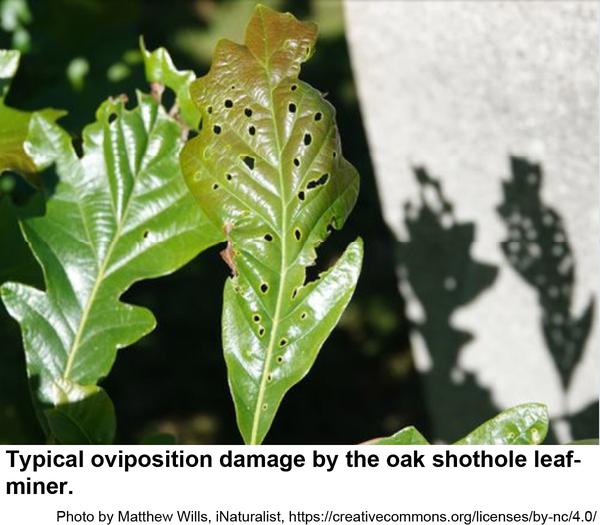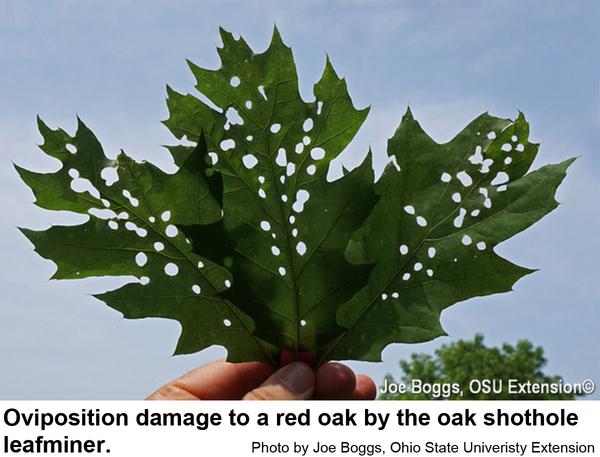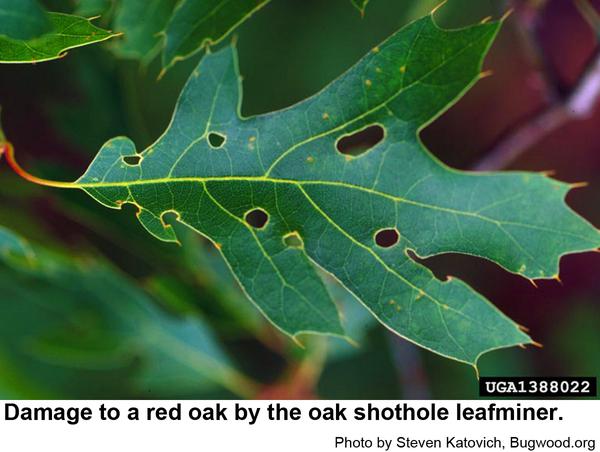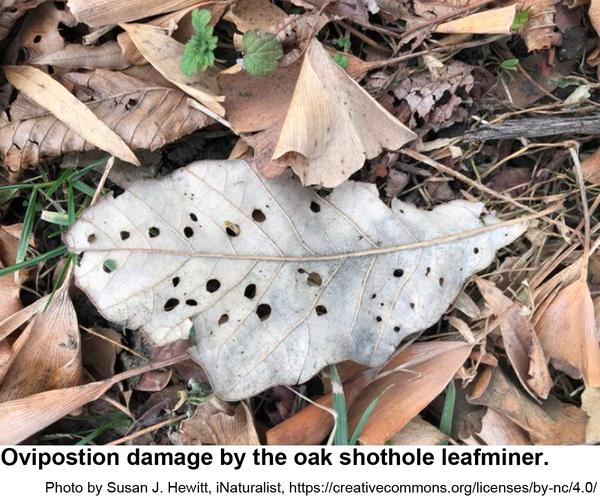Description and Biology
The oak shothole leafminer, Japanagromyza viridula, is a very small fly that emerges in early spring to feed on oak leaf buds and very young leaves. They feed by piercing the buds with their ovipositors (literally "egg placers") and lapping plant juice. As the buds break and new leaves expand, a tiny hole forms at the ovipostion injury site. The holes get bigger (up to 3/8 inch) as the leaves grow. Females eventually pierce leaves to lay eggs inside. Tiny maggots hatch and excavate blotch mines as they mature. Once mature, usually by the end of May, maggots leave their mines and drop to the soil where they pupate and spend the rest of the summer and the winter. Active mines are light green to tan but darken once they're abandoned. The damaged tissue eventually drops away leaving large, ragged holes. Female feeding holes and the leaf mines remain throughout the rest of the growing season. We have one generation per year in North Carolina.
Host Plants
Black oak, burr oak, Chinese chestnut, post oak, red oak, sand post oak, scrub oak, turkey oak, and white oak have all been reported as hosts of the oak shothole leafminer.
Residential Recommendations
Like most leafminers in this family, oak shothole leafminers have numerous parasites. Next year the infestation may not even be noticeable because of the parasites. Usually by the time the damage is noticed, the leafminers have already abandoned the mines. Applying a pesticide during the growing season will not help improve the appearance of an infested tree. It is probably better not to try to control these leaminers with pesticides.
Other Resources
- A new species of Japanagromyza (Diptera: Agromyzidae) from Florida, with a key to North American species. Wiegmann, B.M. (1991)Proceedings of the Entomological Society of Washington, 93 (1), 62–66.
- A Single Leaf Diagnostic Case Study. Boggs, J. 2017. Buckeye Yard & Garden onLine.
- Holey Oaks. Boggs, J. 2020. Buckeye Yard & Garden onLine.
- Japanagromyza viridula Coquillett, 1902. No Date, prob. 2017. Anonymous. Global Biodiversity Information Facility.
- New state and host records for Agromyzidae (Diptera) in the United States, with the description of thirty new species. Eiseman, C. S. and O. Lonsdale. 2018. Zootaxa 4479 (1): 1-156.
- Scuzzy Looking Oaks. Boggs, J. 2019. Buckeye Yard & Garden onLine.
- NC State Extension Plant Pathology Publications
- NC State Horticultural Science Publications
- North Carolina Agricultural Chemicals Manual
For assistance with a specific problem, contact your local N.C. Cooperative Extension center.
This factsheet has not been peer reviewed.
Publication date: July 7, 2020
Reviewed/Revised: May 7, 2025
N.C. Cooperative Extension prohibits discrimination and harassment regardless of age, color, disability, family and marital status, gender identity, national origin, political beliefs, race, religion, sex (including pregnancy), sexual orientation and veteran status.




